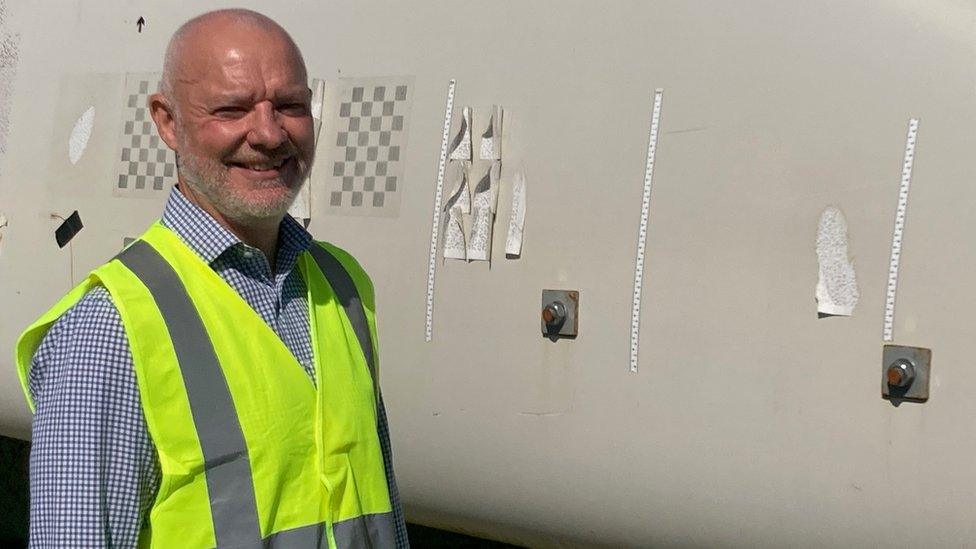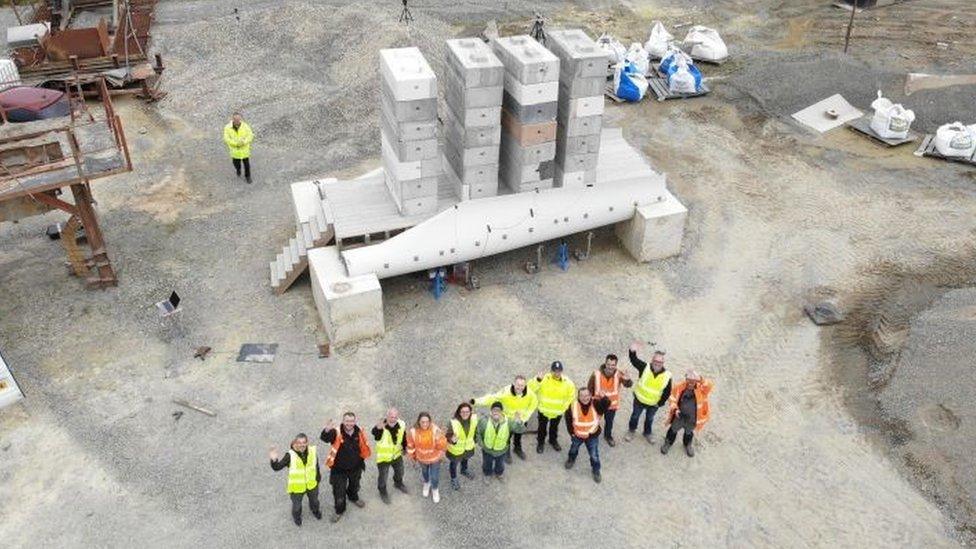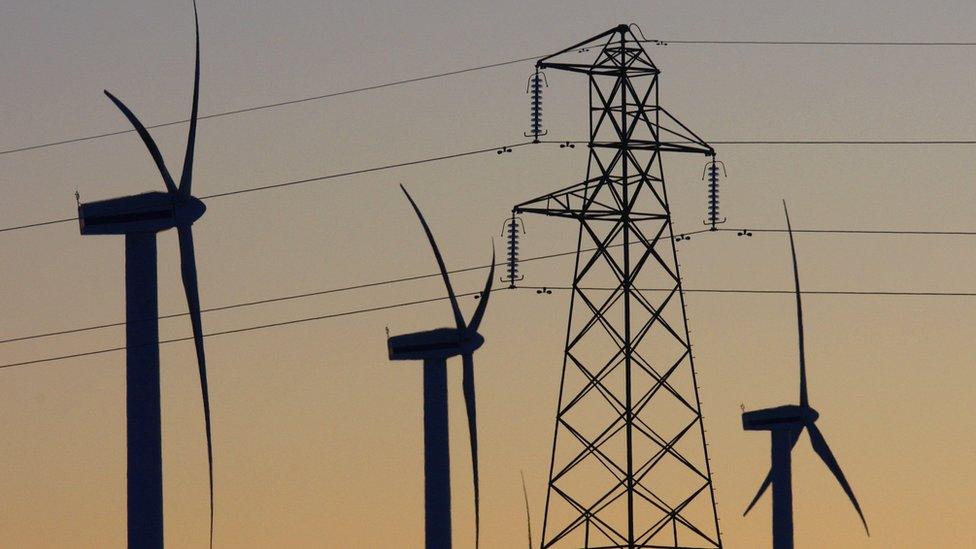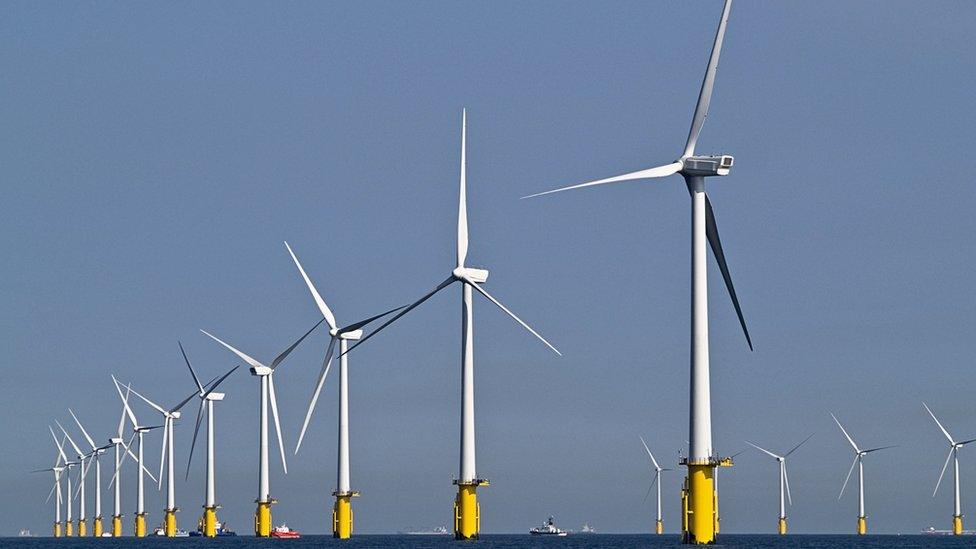Renewable energy: The upcycled wind turbines getting a second life
- Published
- comments

Kenny McDonald is the technical manager of a project led by Queen's University Belfast to find new use for wind turbine blades
When is a wind turbine not a wind turbine?
When it's been turned into a bridge. Or street furniture. Or, in the future, possibly even a telecoms tower.
Welcome to the world of turning wind power non-recyclables into upcycled everyday objects.
Researchers led by Queen's University Belfast have been trying to find ways of repurposing the structures, also known as wings.
While wind turbines are heroes of renewable energy generation, their blades are not currently recyclable and have to be landfilled or incinerated.
By 2030, it is estimated 450 blades on the island of Ireland will be at the end of 20 to 25 years usefulness generating power - 110 of them in Northern Ireland.
The project team has proved the blades can be safely made into small bridges, suitable for greenways and culverts.
The work has also led to a spin-off business looking at street furniture and other possibilities.

The project team has proved the blades can be safely made into small bridges, suitable for greenways and culverts
"The blades are only designed for a 20-25 year lifespan," said Kenny McDonald, the technical manager for the project.
"There wasn't thought about where these are going to go once they're decommissioned off the turbine itself.
"So it's a challenge for the US/Ireland project we're involved in."
A surprising prototype
Queen's worked on the project with University College Cork, Munster Technology College and two institutions in the Unites States - Georgia Technical College in Atlanta and City University in New York.
The design team began with two blades and came up with the idea for a bridge - 7m long and 2m wide.
With open space secured for building the prototype at Creagh Concrete in Draperstown, County Londonderry, work began in the Belfast lab to bring the researchers' vision to life.
That required hours of careful measuring before any cuts were made.

Kenny McDonald was surprised with the success of the project
The success of the final structure surprised even Kenny.
"If you think about it, the safe working load for this bridge was deemed to be six tonnes.
"We managed to put over 34 tonnes on top of it.
"And when all the load is taken off, the bridge goes back to within half a millimetre of its original position."
Now, the plan is to get funding to try joining two blades together to increase both the size of the bridge and the possibilities.
"Globally, our Re-Wind project estimates that by 2042, 8.6m tonnes of wind turbine blade material is going to have to find some sort of reuse," said Queen's project lead Prof Jenny McKinley.
"Some of the most common options that we have are - there are some children's play parks made of wind turbine blades; there are bicycle shelters made of wind turbine blades.
"But those are only one or two. We really need a much more sustainable large-scale option."
Clock is ticking
By 2037, the team estimates 9,600 tonnes of blade material will need to be repurposed on the island of Ireland.

Finding solutions to that challenge gave PhD student Angie Nagle her doctorate and also a start-up business plan reusing blades.
"The potential is huge to repurpose these items, I mean people pay a fortune to get a bridge made from this glass fibre reinforced polymer material - GFRP.
"It's very expensive material, it's incredibly durable, it's incredibly strong.
"They have been basically cyclically loaded for 20 to 30 years, but when put in static applications, such as using them as girders for pedestrian bridges, they can last for another 60 years.

Re-using wind turbines has 'huge potential'
"It's a huge asset. You should consider it kind of a local resource."
Why is this work important?
Wind turbines have proliferated across the island of Ireland in recent decades.
Now, whole farms are being decommissioned and the question of what to do with the blades is a focus.
Work continues among scientists around the world to find more sustainable material to use for constructing blades, or a way to recycle the existing material.
Repurposing the blades while that work continues gives time for solutions to be found and allows them to be useful for longer.
Landfilling blades, or incinerating them is a big sustainability no-no for a sector that prides itself on being a leader in the fight against climate change.
- Published16 May 2023

- Published6 September 2022
